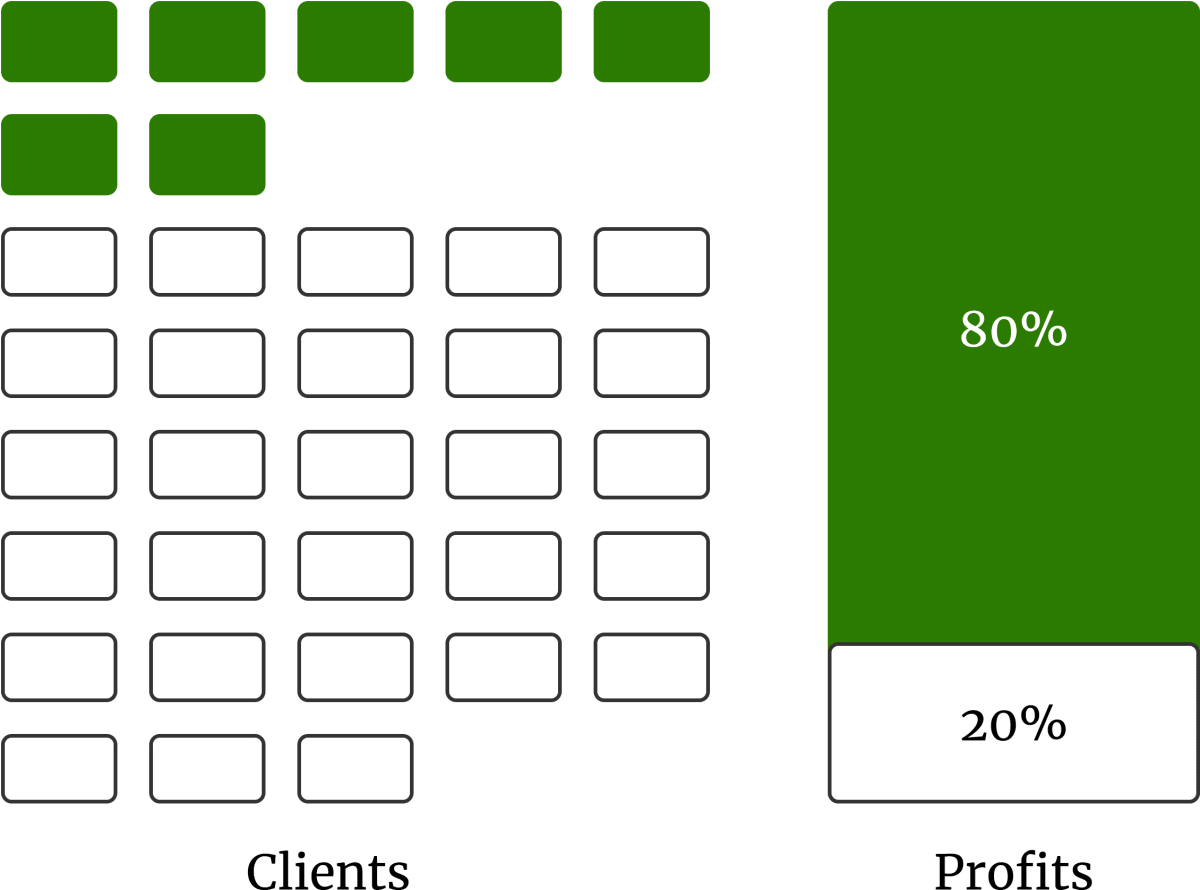How the 80/20 rule can grow your business (like it has ours)
(By the way, to get articles like this free in your inbox, subscribe to our newsletter.)
Although we’ve written about the power of efficient workflows many times (including here, here, and here), those articles mostly sidestep a critical question:
What exactly should we be working on?
Smooth processes are vital to business growth, but only when doing the right work.
In this article, you’ll learn how we use The Pareto Principle (or 80/20 rule) to focus our minds on the right work and minimize everything else. You’ll also see:
- Why some things matter way more than others.
- How to look for 80/20 opportunities in your business.
- Five ways we leverage 80/20 thinking at Conversion Rate Experts.

Why the best opportunities can be hard to see
The Pareto Principle—popularized as the 80/20 rule or Law of the Vital Few—is a reminder that the world is often way out of balance.
The original insight came from an Italian economist, Alfredo Pareto. While studying 19th-century society, Pareto took the then innovative step of comparing two sets of data—wealth and population. The results astounded him. No matter what country or period he studied, a small minority of citizens held a vast and consistent majority of the wealth.
Although unremarkable today, this fact represented a huge and hidden asymmetry in Pareto’s world. The scale was impossible to grasp unless you had the numbers. Intuition wasn’t enough.
Later studies (by Pareto and many others) have revealed asymmetries in many areas of life, including business. They are equally hard to find through intuition alone, but when we take the time to gather the data, we can often leverage them to grow our business.
What’s the real value of 80/20 thinking?
The core idea of 80/20 is this: 20% of inputs generate 80% of outputs.
The modern spread of this idea is largely down to Richard Koch’s million-selling book, The 80/20 Principle. Koch’s title is a masterful simplification of Pareto’s findings, but if anything, it worked too well. The internet is awash with unchallenged assertions presented as natural laws:
- 20% of software bugs cause 80% of customer complaints.
- 20% of advertising generates 80% of leads.
- 20% of employees account for 80% of office cookie evaporation.
Yes, we made that last one up, but only to illustrate that most 80/20 assertions are, at best, simplifications of a messy world. As Koch explains, there is nothing inherently magical about the ratio—in fact, the numbers will rarely sum to 100 in the real world. If you examine your business—which we highly recommend—you are just as likely to discover asymmetries of 84/26, 78/6, 75/7, or even 99/5.
The real value of 80/20 is as a reminder of Pareto’s fundamental lesson. The world is unbalanced. Some things matter more than others. Not just a little more. Way more. And they are hard to see through intuition alone.
How to find the 80/20 opportunities in your business
Pareto’s innovation was to compare two related data sets, and that’s the place to start. Find something that matters to you, and measure it against a related metric. Here are a few high-level examples:
- Agencies might relate clients to profit.
- SaaS companies might relate customer lifetime value to customer market.
- Manufacturers might relate products to product recalls.
- Retailers might relate sales to store locations.
- Call centers might relate customer issues to call volumes.
Imagine a law firm comparing clients and profit. Last year, they served 35 companies and made $3,500,000 in profit. All they need is a list of those clients ordered by profit and a calculator. How far down the list do they need to go before reaching 80% of their profit?

The Pareto Principle says that they’d stop at the 7th client. In other words, they could walk away from 28 of their clients (80%) and still make $2,800,000 in profit.
We’re not suggesting that walking away is the right response, but they might ask why (or how) they serve so many “low‑value” clients. Or what commonalities exist among the profitable “20% clients”. Whenever we find an 80/20 insight, it suggests two things—what to do more of and what to do less of.
And when we replace low‑value work with high-value work, business growth can accelerate fast.
You’d be amazed at how much time companies waste on low-value work. They are adrift on the wrong side of the ratio, doing 80% activities that deliver 20% of the return.
How 80/20 saved our client a big pile of money
One of our clients was struggling with rising call center volume as business grew. Some businesses might consider this inevitable, but this doesn’t have to be the case. We worked with our client to apply 80/20 thinking, starting with a simple question:
What 20% of problems generate 80% of customer calls?
(Remember—find something that matters to you, and measure it against a related metric.)
Once we’d ranked the most common questions, we took a fresh look at the client’s website. How could we improve, remove, or better explain the elements that were confusing customers?
Once we’d made the changes, call center volume dropped by 66%.
Five ways we leverage 80/20 thinking at Conversion Rate Experts
This article began with a question—what exactly should we be working on? Here are five examples to answer that question and make The Pareto Principle more concrete.
1. Testing: The ultimate 80/20 business activity
We’ve built a business around high-value (80/20) activity. Most companies never test their websites, even though they could double or triple their profits. We helped one FinTech company grow by 470%.
Our results page contains over 100 similar testimonials and success stories revealing how we’ve transformed companies of all types by applying scientific principles and obsessing over high-value wins. Here’s how we describe our approach to new and prospective clients:
… after each success, we ask, “What were the vital few activities that bore the most fruit? What were the 20% of activities that gave the best results?” The answers help us to become increasingly effective.
This is 80/20 thinking. We systematically stack the deck in favor of our clients, widening the gap between them and their competition. As you read on, note how each example accelerates that goal.
2. Research: The power of knowing what to test
Testing is not enough. Most companies don’t do it, but many that do waste time focusing on the wrong things.
When a new client joins us, our Research, Usability, and Analytics department gets to work. They gather data on the client’s website, visitors, and bottlenecks. This research is the backbone of the CRE Methodology™, often generating tens or hundreds of growth opportunities. How do we prioritize the 20% of tests likely to generate 80% of the biggest wins?
The following excerpt from our unique CRE Methodology™ lists three questions we ask to 80/20 our testing strategy:
It’s a myth that you can transform a business by making “meek tweaks”; extraordinary improvements come from extraordinary ideas. We take all of the ideas we’ve generated from the research and prioritize those big, bold, targeted ones that will grow your business in the shortest time. Bold changes give you more profit, and you get quicker, larger returns (it’s a statistics thing). And they’re usually more fun. If you carry out “meek tweaking,” on the other hand, your tests seldom reach significance, you get disheartened, and, most upsettingly of all, you lose the commitment of your colleagues.
- How likely is it to double your conversion rate? Asking this question helps to ensure that we’re prioritizing the big opportunities. Bigger, bolder tests are given a higher priority; meek tweaks are demoted.
- How easy is it to implement the test? We’re looking for the quick wins with the biggest financial impact, so changes that are easy to implement are given a higher priority.
- Has this idea worked before? Once you’re testing, you’ll quickly start learning what your visitors respond to. Every test we develop is documented so that we can review and prioritize ideas that are inspired by winning tests.
The benefit of our approach compounds over time. We’ve grown companies around the world and in over 80 separate verticals. If we want to review the top 20% of tests in a particular market—drawing on more than 15 years of success—we can.
3. Hiring: The best people are worth ten times more than the next best
The Pareto Principle tells us that 20% of any team will deliver 80% of its results. At Conversion Rate Experts, we see this as a challenge to hire the very best people in the world.

Many businesses underestimate the difference between an average team member and a world‑class one. Our team includes successful entrepreneurs, Amazon best‑selling authors, Cambridge scientists, heads of agencies, veterans of direct response marketing, and former employees of Google, eBay, Ogilvy & Mather, and BAE Systems.
Our growth has come from our reputation for getting amazing results, so our unique 7-stage recruitment process is designed to help us find the best people… and to help them find us.
4. 80/20 workflows: How we minimize low‑value work
Pareto’s most sobering insight is that roughly 80% of our work has little value. Ouch. How might we improve those numbers and feel better about ourselves?
We are always thinking about how our low‑value work can be turned into no work—either by removing the need for the activity or creating a flow to replace it. In fact, Conversion Rate Experts is mostly just a complex system of optimized flows created by plain-English programmers. Everything we do—from onboarding team members to creating client testimonials—has its own flow. That way, we can fight back the 80% and focus on high-value work that delivers out-sized results.
A good flow gets a job done without using the user’s time, effort, memory, and brainpower. Learn more about how we do this from our Infinite Manager series.
5. Failing fast: Use 80/20 thinking to fail faster (and succeed more)
Failure is never fun, but the only thing worse than a failure is a dragged-out Hollywood death of a failure—when some project hangs on only to fall at the final… uh… hurdle.
If you are going to fail, fail fast.
A while ago, we had a face-palm moment when we realized we were doing our internal projects all wrong. You can read more about it in our article, Triple R: a new technique to accelerate your progress.
Triple R rarely takes us more than a few minutes, but has accelerated almost every area of our business. As a company, we are big fans of testing, and you can progress much faster if you increase the rate at which you explore avenues and abandon the dead ends.
Next steps: What should you focus on?
Many 80/20 articles imply you should fire your clients, discontinue your products, or cull your to-do list, but business is rarely so clear-cut.
Shift your thinking and look beneath the surface of your work. In all likelihood, there are big wins to be had, but it takes time (and sometimes courage) to find them.
Start by internalizing Pareto’s fundamental lesson. The world is unbalanced. Some things matter more than others. Not just a little more. Way more. And they are often hard to see.
We can’t tell you what to focus on—unless you’d like to book a free one-on-one strategy session—but we can confirm that companies who root out and replace low‑value activity far outpace their competition.
If you critically examine your business, you’ll find the 20% that matters most.
Scale that.
How much did you like this article?
What’s your goal today?
1. Hire us to grow your company
We’ve generated hundreds of millions for our clients, using our unique CRE Methodology™. To discover how we can help grow your business:
- Read our case studies, client success stories, and video testimonials.
- Learn about us, and our unique values, beliefs and quirks.
- Visit our “Services” page to see the process by which we assess whether we’re a good fit for each other.
- Schedule your FREE website strategy session with one of our renowned experts.
Schedule your FREE strategy session
2. Learn how to do conversion
Download a free copy of our Amazon #1 best-selling book, Making Websites Win, recommended by Google, Facebook, Microsoft, Moz, Econsultancy, and many more industry leaders. You’ll also be subscribed to our email newsletter and notified whenever we publish new articles or have something interesting to share.
Browse hundreds of articles, containing an amazing number of useful tools and techniques. Many readers tell us they have doubled their sales by following the advice in these articles.
Download a free copy of our best-selling book
3. Join our team
If you want to join our team—or discover why our team members love working with us—then see our “Careers” page.
4. Contact us
We help businesses worldwide, so get in touch!
© 2025 Conversion Rate Experts Limited. All rights reserved.















